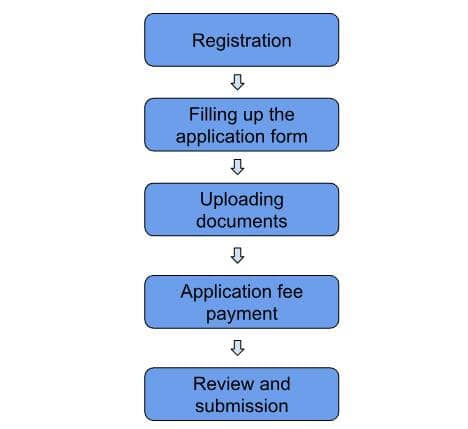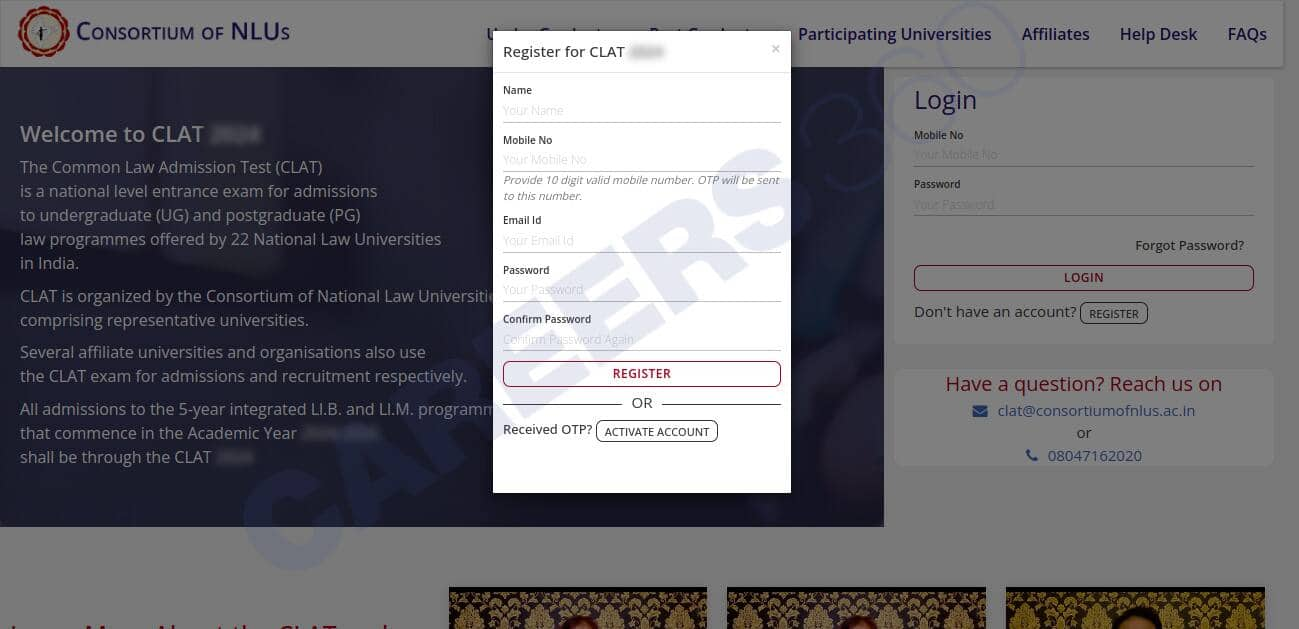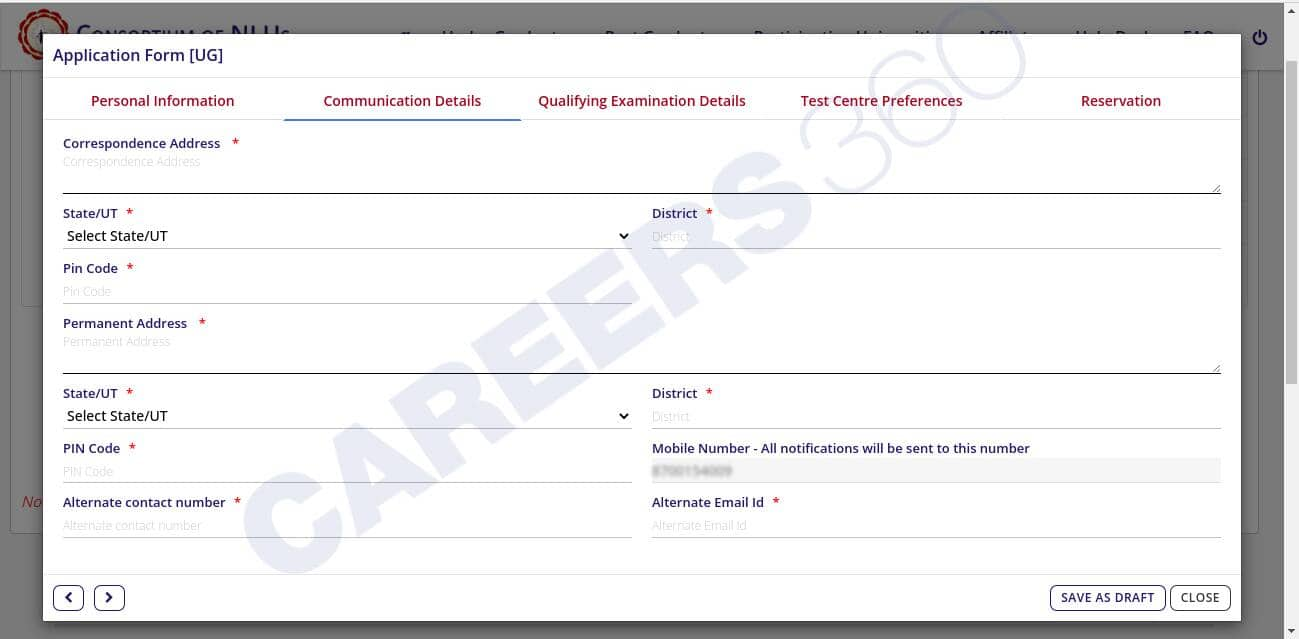Amity University-Noida Law Admissions 2026
Among top 100 Universities Globally in the Times Higher Education (THE) Interdisciplinary Science Rankings 2026
The Consortium of National Law Universities (CNLUs) has closed the CLAT 2026 registration on November 7, 2025. Interested and eligible candidates could apply for CLAT 2026 by visiting the official website: consortiumofnlus.ac.in before the CLAT 2026 registration last date. The consortium has also closed the CLAT 2026 application form correction, allowing registered candidates to edit their test location preferences and update their details on November 9, 2025, 11.59 pm. However, no applications will be accepted for corrections after this date. Candidates must pay the CLAT 2026 registration fees of Rs. 4,000 for the general category and Rs. 3,500 for SC/ST candidates to complete the CLAT form. There is a notable change in CLAT 2026 registration, that candidates had to fill in their NLU preferences after the declaration of the CLAT 2026 result. Earlier, the CLAT 2026 registration started on August 1, 2025. In this article, candidates will get all details about the application process, CLAT exam fees, correction window, last date to apply and how to apply for CLAT 2026 and more.
This Story also Contains

The CLAT 2026 registration details include providing personal information, communication, education details, and test centre preferences. The Consortium of National Law Universities will conduct CLAT 2026 on December 7, 2025 from 2 pm to 4 pm, in offline mode. The scores in the Common Law Admission Test will be accepted by 24 National Law Universities and more than 60 law schools across the country.
Event | Dates |
Release of CLAT 2026 admission notification | July 20, 2025 (Out) |
Opening of CLAT 2026 application | August 1, 2025 (Started) |
CLAT 2026 registration last date |
November 7, 2025 (Closed) |
CLAT 2026 application correction last date | November 9, 2025, 11:59 pm (Closed) |
Release of CLAT 2026 admit card | 15 days before the exam |
CLAT 2026 exam date | December 7, 2025 from 2 pm to 4 pm |
The Consortium of NLUs prescribed the CLAT 2026 eligibility criteria on its official website. The CLAT 2026 eligibility criteria include the minimum educational qualification, minimum passing marks, and age limit. The detailed CLAT eligibility criteria 2026 are mentioned in the table below.
Particulars | Details |
CLAT UG 2026 Eligibility Criteria | There is no upper age limit for candidates appearing for CLAT UG 2026. Passed Class 12 with at least 45% marks or 40% marks or equivalent in the case of SC/ ST/ PwD categories. Candidates appearing for Class 12 exams are also eligible to apply and they are required to produce evidence of their passing the qualifying exam at the time of admission. |
CLAT PG 2026 Eligibility Criteria | Passed LLB (3-year LLB or 5-year LLB) with at least 50% marks or its equivalent grade in case of candidates belonging to General/OBC/NRI categories (45% in the case of SC/ ST/ PwD candidates). Candidates appearing for final year graduation exams can also apply. There is no upper age limit for appearing for the CLAT PG 2026. |
Among top 100 Universities Globally in the Times Higher Education (THE) Interdisciplinary Science Rankings 2026
Ranked #18 amongst Institutions in India by NIRF | Ranked #1 in India for Academic Reputation by QS Rankings | 16 LPA Highest CTC
The documents, such as photographs, signature or domicile certificate, will be accepted in the prescribed format as mentioned below.
Document | Image size (maximum) | Format |
Photograph | 500 KB | jpg/jpeg or PNG |
Signature | 100 KB | jpg/jpeg or PNG |
State of domicile certificate | 1.5 MB |
The CLAT application form-filling process is done completely online through the official website of the Consortium of NLUs - consortiumofnlus.ac.in. The CLAT 2026 application process will involve steps such as registration, uploading of relevant documents, detailed application form filling and application fee payment. Candidates must fill out the form before the CLAT 2026 application form last date. The step-by-step process to complete CLAT 2026 registration has been mentioned in the section below.

Filling out the CLAT 2026 application form consists of the steps mentioned below:

To complete the initial registration, the first step is to submit the CLAT application form 2026. The CLAT 2026 registration can be completed by following the steps:

Once the CLAT 2026 registration is completed, candidates will have to fill out the detailed application form. The detailed CLAT 2026 application form has been divided into five sections: personal information, communication details, qualifying examination details, test centre preferences, and reservation. The details to be filled in each section have been given below:
In this section, candidates must provide their permanent address and communication address details, email ID and phone number. Candidates must note that the entire admission and CLAT counselling process is conducted in online mode.
While filling this section of the CLAT 2026 application form, the candidate has to enter details about their educational qualification, which include (Class 10, Class 12 for UG, LLB for LLM), name of the board or university, passing status, percentage/ CGPA, month and year of passing the exam.
In the test centre preferences section, candidates will have to enter three CLAT exam centres in the order of their preference. Candidates will be allotted their exam centres based on their preference and the availability of seats at the exam centre. CLAT 2026 will be conducted at around 89 cities in India. The list of CLAT 2026 exam centres is given below:
State | Test Cities |
Andhra Pradesh | Chittor/Tirupathi |
Kurnool | |
Rajahmundry | |
Vijayawada | |
Vishakapatnam | |
Assam | Guwahati |
Bihar | Muzaffarpur |
Patna | |
Chhattisgarh | Bilaspur |
Durg | |
Raipur | |
Gujarat | Gandhinagar |
Rajkot | |
Surat | |
Vadodara | |
Haryana | Faridabad |
Gurugram | |
Hisar | |
Kurukshetra | |
Sonepat | |
Himachal Pradesh | Shimla |
Jammu and Kashmir | Jammu |
Srinagar | |
Jharkhand | Jamshedpur |
Ranchi | |
Karnataka | Bengaluru |
Hubli / Dharwad | |
Mangalore | |
Mysore | |
Kerala | Calicut |
Ernakulam | |
Kottayam | |
Thiruvananthapuram | |
Madhya Pradesh | Bhopal |
Gwalior | |
Indore | |
Jabalpur | |
Maharashtra | Amrawati |
Aurangabad | |
Mumbai | |
Nagpur | |
Navi Mumbai | |
Pune | |
Thane | |
Manipur | Imphal |
Meghalaya | Shillong |
National Capital Territory of Delhi | New Delhi |
Odisha | Bhubaneswar |
Cuttack | |
Punjab | Amritsar |
Jalandhar | |
Mohali | |
Patiala | |
Chandigarh UT | Chandigarh |
Rajasthan | Jaipur |
Jodhpur | |
Kota | |
Sikkim | Gangtok |
Tamil Nadu | Chennai |
Coimbatore | |
Madurai | |
Salem | |
Tirunelveli | |
Trichy | |
Telangana | Hyderabad |
Tripura | Agartala |
Union Territory | Puducherry |
Union Territory (part of Dadra and Nagar Haveli) | Silvassa |
Union Territory (part of Daman and Diu) | Diu |
Uttar Pradesh | Agra |
Allahabad | |
Bareilly | |
Ghaziabad | |
Gorakhpur | |
Greater Noida / Noida | |
Jhansi | |
Kanpur | |
Lucknow | |
Meerut | |
Varanasi | |
Uttarakhand | Dehradun |
Haldwani | |
West Bengal | Asansol |
Barrackpore | |
Hooghly | |
Kharagpur | |
Kolkata | |
Malda | |
Siliguri |
You may also check:
In this step, candidates must submit the CLAT 2026 application form and upload the required documents. Candidates are required to upload their recent passport-size photographs in plain background and a scanned copy of the candidate's signature in the prescribed format. Candidates from the reserved category will have to upload their category certificate to avail the benefit of reservation.
After uploading the documents, the next step in the application process is to pay the prescribed CLAT registration fees. The CLAT 2026 application fee must be paid in online mode only. The application fee for CLAT 2026 is non-refundable. Given below are the fee details for CLAT 2026.
Category | CLAT Form Fees | Mode of payment |
General/ OBC/ NRI category candidates | Rs. 4,000 | Online: Net Banking Credit Card Debit Card |
SC/ ST/ BPL/ PWD category candidates | Rs. 3,500 |
The last step in the CLAT 2026 application form process is to review all the filled in details and submit the application. Candidates will have to make sure that all the details are correctly filled in. No changes are allowed in the chosen programme and reservation details filled in the CLAT application form 2026. Once all the details have been rechecked, candidates can click on the “Submit” button to complete the application process.
The Consortium of NLUs has closed the CLAT 2026 application form correction window on its official website- consortiumofnlus.ac.in. Candidates could make the corrections to the CLAT application form 2026 through the official website by logging into their CLAT account. However, the correction window is the only way to make modifications to the CLAT application form.
Given below are a few points on CLAT registration 2026 for candidates applying under the NRI/ NRI sponsored category.
Some of the important points to remember when filling up the CLAT 2026 application form are mentioned below:
You may also check popular Law Degrees:
Candidates can recover the CLAT 2026 login password by using the "Forgot password" option. Upon using it, candidates would be sent an OTP to reset the password on their registered mobile number. With the help of the OTP candidates would be able to set a new password and access their CLAT 2026 account.
Particulars | 2025 | 2024 | 2023 | 2022 | 2021 | 2020 |
CLAT Registration | Number of candidates registered for CLAT UG: 62,832 Number of candidates appeared for CLAT UG: 60,544 Number of candidates registered for CLAT PG: 16,082 Number of candidates appeared for CLAT PG: 14,817 | Number of candidates registered for CLAT UG: 54,808 Number of candidates appeared for CLAT UG: 53,180 Number of candidates registered for CLAT PG: 12,782 Number of candidates appeared for CLAT PG: 12,005 | Number of candidates registered for CLAT UG: 44,763 Number of candidates appeared for CLAT UG: 42,766 Number of candidates registered for CLAT PG: 9,490 Number of candidates appeared for CLAT PG: 8,703 | Number of candidates appeared for CLAT UG: 53,226 Number of candidates appeared for CLAT PG: 6,217 | Number of candidates appeared for CLAT UG: 53,532 Number of candidates appeared for CLAT PG: 8,574 | Number of candidates appeared for CLAT UG: 53,226 Number of candidates appeared for CLAT PG: 6,217 |
The NLUs offer domicile reservations for the candidates. Under domicile reservation as per the CLAT 2026 reservation criteria, candidates from the state where the NLU is located are given special reservations in seats. Candidates to claim this reservation will have to upload their domicile certificate in PDF form. The reservation details for all NLUs are given below:
NLUs | Domicile % |
NLSIU Bengaluru | 25% |
NALSAR Hyderabad | 25% |
WBNUJS Kolkata | 33% |
NLIU Bhopal | 50% |
NLU Jodhpur | 25% |
HNLU Raipur | 50% |
GNLU Gandhinagar | 25% |
GNLU Silvassa Campus | 25% |
RMLNLU Lucknow | 45% |
RGNUL Patiala | 10% |
CNLU Patna | 50% |
NUALS Kochi | 49% |
NLUO, Odisha, Cuttack | 25% |
NUSRL Ranchi | 50% |
NLUJA Assam, Guwahati | 50% |
DSNLU Visakhapatnam | 48% |
TNNLU Tiruchirappalli | 48% |
MNLU Mumbai | 62% |
MNLU Nagpur | 62% |
MNLU Aurangabad | 62% |
HPNLU Shimla | 25% |
DNLU Jabalpur | 50% |
DBRANLU, Sonipat, Haryana | 25% |
NLUT Agartala | 30% |
In case of any doubts or issues regarding filling up the CLAT 2026 application form, candidates can contact the NLU consortium through the official helpline as mentioned below.
Particulars | Details |
Email id | clat@consortiumofnlus.ac.in |
Contact number | 08047162020 (10:00 am to 05:00 pm on all working days) |
Candidates who completed the CLAT registration 2026 can be able to download their admit cards in due time. The CLAT 2026 admit card will be released tentatively in the third week of November 2025. Students must note that the CLAT admit card 2026 is a mandatory document that needs to be carried on the day of the exam to get entry inside the examination hall. Students can download their CLAT admit card by logging in to the candidate portal with valid credentials.
You may also read:
Through the Common Law Admission Test (CLAT), a total of 24 National Law Universities (NLUs) and some affiliated colleges across India offer admission to undergraduate and postgraduate law programmes.
CLAT 2026 Participating NLUs | |||
|---|---|---|---|
1 | 13 | ||
2 | 14 | ||
3 | 15 | ||
4 | 16 | ||
5 | 17 | ||
6 | 18 | ||
7 | 19 | ||
8 | 20 | ||
9 | 21 | ||
10 | 22 | ||
11. | 23 | ||
12 | 24 | ||
| 25 | RPNLU Prayagraj | 26 | IIULER Goa |
Frequently Asked Questions (FAQs)
No, CLAT 2026 will be held once in December.
CLAT 2026 will be conducted on December 7, 2025 in offline mode.
The CLAT 2026 application form was opened on August 1, 2025. The deadline to submit the CLAT 2026 application form was November 7, 2025.
The CLAT 2026 application fee for General / OBC / PWD/ NRI / PIO / OCI candidates was Rs 4,000. SC / ST / BPL candidates had to pay a registration fee of Rs 3,500.
On Question asked by student community
With an AIR of 34724 and OBC category rank of 7153, chances of getting a seat in DSNLU Visakhapatnam are low in early rounds. However, since you are already invited for counselling, there may be some chance in later rounds depending on seat vacancy and cut-off movement. You should participate
With a CLAT LLM rank of 13656, getting a top NLU is difficult. You may have chances in lower-ranked NLUs or private law universities, depending on seat availability and category.
You can check CLAT LLM counselling details here:
https://law.careers360.com/articles/clat-llm-cut-off
With a CLAT PG rank of 1257 in the SC category and being a woman candidate with Rajasthan domicile, you do have a realistic chance of securing admission to several National Law Universities, though the top NLUs may be difficult at this rank. Admission chances depend heavily on category-wise cut-offs,
With a CLAT PG rank of around 11,000, getting admission into the top National Law Universities (NLUs) is not likely, as their general category cut-offs usually close much earlier. However, you still have realistic chances in lower-ranked and newer NLUs, especially in the later rounds of CLAT counselling or through
With a CLAT 2026 All India Rank around 2070, Telangana domicile, and holding an OBC certificate (girl candidate), your chances of getting admission into a top-tier NLU like NLSIU Bengaluru, NALSAR Hyderabad, NUJS Kolkata or NLU Jodhpur are quite low, as their closing ranks are usually much higher. However, you
Among top 100 Universities Globally in the Times Higher Education (THE) Interdisciplinary Science Rankings 2026
Ranked #18 amongst Institutions in India by NIRF | Ranked #1 in India for Academic Reputation by QS Rankings | 16 LPA Highest CTC
AICTE & UGC Approved | NAAC A+ Accredited
NAAC A++ Approved | Curriculum Aligned with BCI & UGC
India's Largest University | BCI approved | Meritorious Scholarships up to 5 lacs |
Integrated Learning – A balanced blend of management and legal education